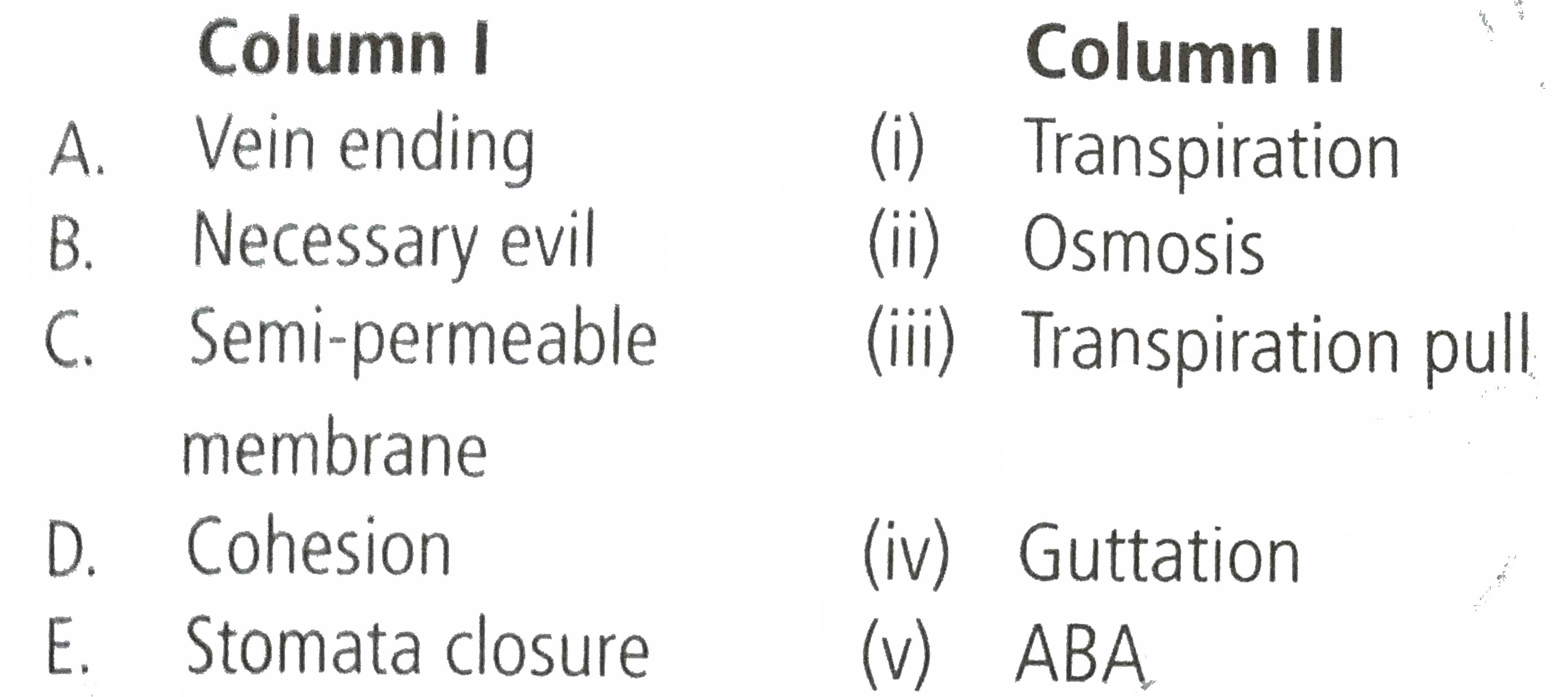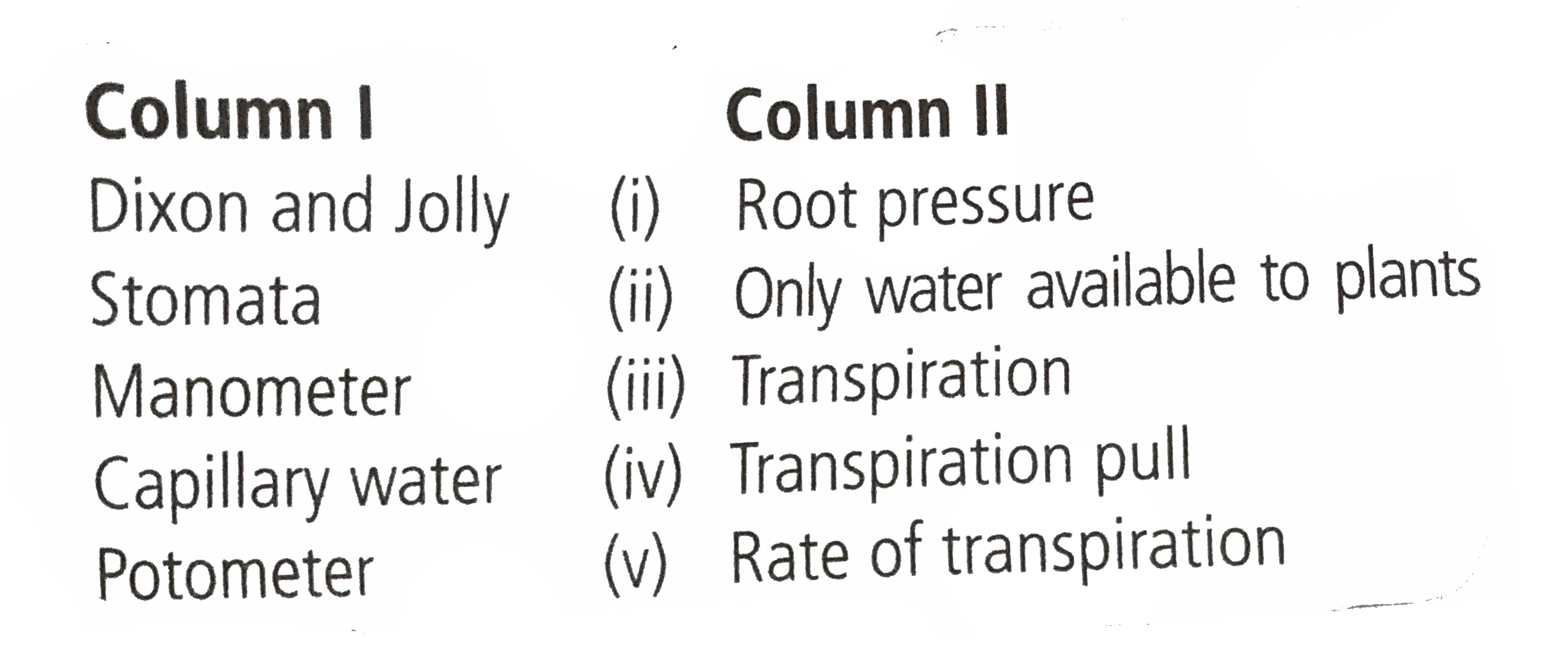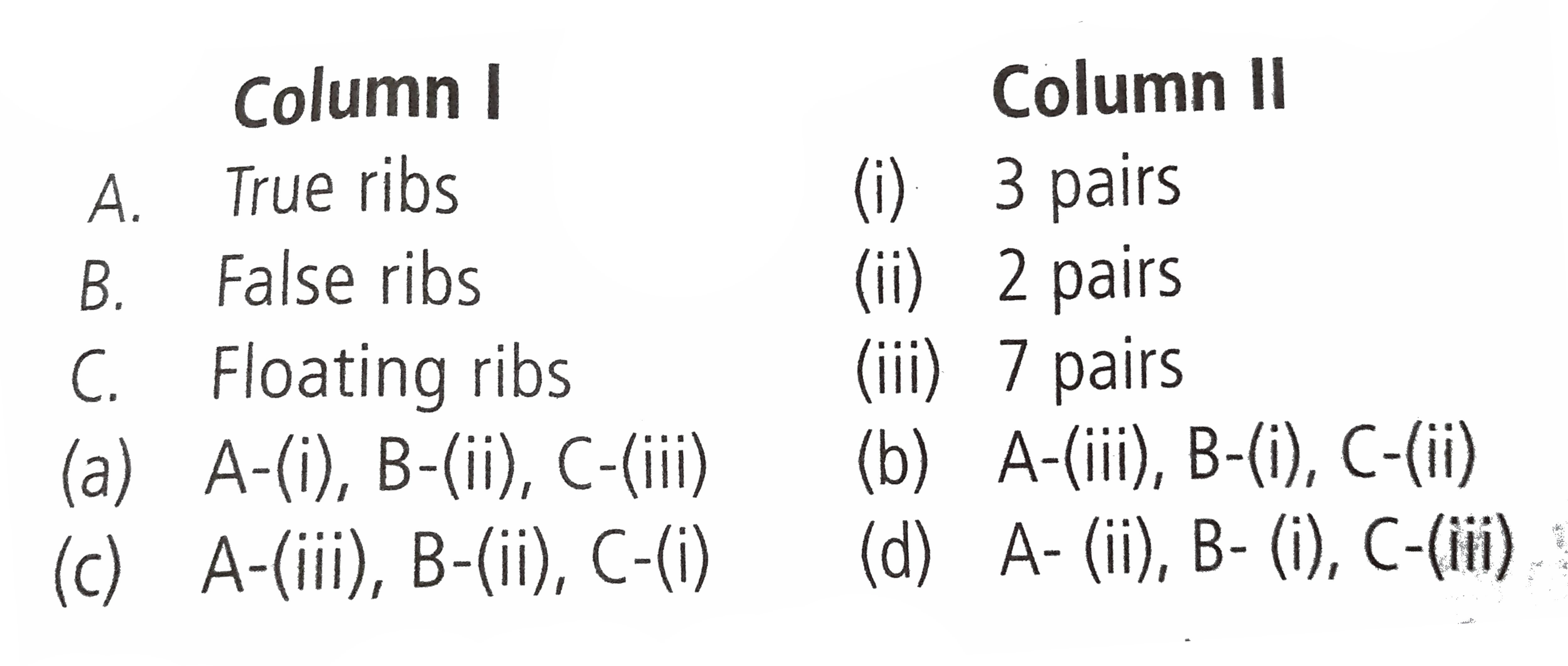Match column I with column II and select the correct option from the given codes.
column IColumn IIArtermisla tridentata(i)Grows better in overgrazed areaCapparis spinosa(ii)Drominate in areas destructed by firesPleris aquilina and Pyronema(iii)Indicates intense soil erosionAmaranthus and Chenopodium(iv)Saline soils
I,ii,iii,iv
ii,iii,iv,i
iii,I,ii,iv
iv,iii,ii,i
The correct Answer is:D
To solve the matching question, we will analyze each item in Column I and find the correct corresponding item in Column II.
1. Identify Artemisla tridentata:
- This plant, also known as Big Sage Bush, is adapted to arid and semi-arid conditions. It can grow in saline soils and is known to thrive in overgrazed areas.
- Match: Artemisla tridentata → (i) Grows better in overgrazed area.
2. Identify Capparis spinosa:
- Commonly known as Keppelbush or Flinders rose, this plant has fleshy leaves and large flowers. It is known to indicate soil erosion, particularly in areas where the soil has been disturbed.
- Match: Capparis spinosa → (iii) Indicates intense soil erosion.
3. Identify Pleris aquilina and Pyronema:
- This refers to a genus of fungi that typically dominates areas that have been destroyed by fire. These fungi are known to thrive in post-fire environments.
- Match: Pleris aquilina and Pyronema → (ii) Dominates in areas destructed by fires.
4. Identify Amaranthus and Chenopodium:
- These plants are known to grow well in saline soils and are often found in disturbed or overgrazed areas.
- Match: Amaranthus and Chenopodium → (iv) Saline soils.
Final Matches:
- Artemisla tridentata → (i) Grows better in overgrazed area.
- Capparis spinosa → (iii) Indicates intense soil erosion.
- Pleris aquilina and Pyronema → (ii) Dominates in areas destructed by fires.
- Amaranthus and Chenopodium → (iv) Saline soils.
Correct Option:
The correct option is D.
---
- This plant, also known as Big Sage Bush, is adapted to arid and semi-arid conditions. It can grow in saline soils and is known to thrive in overgrazed areas.
- Match: Artemisla tridentata → (i) Grows better in overgrazed area.
- Commonly known as Keppelbush or Flinders rose, this plant has fleshy leaves and large flowers. It is known to indicate soil erosion, particularly in areas where the soil has been disturbed.
- Match: Capparis spinosa → (iii) Indicates intense soil erosion.
- This refers to a genus of fungi that typically dominates areas that have been destroyed by fire. These fungi are known to thrive in post-fire environments.
- Match: Pleris aquilina and Pyronema → (ii) Dominates in areas destructed by fires.
- These plants are known to grow well in saline soils and are often found in disturbed or overgrazed areas.
- Match: Amaranthus and Chenopodium → (iv) Saline soils.
- Artemisla tridentata → (i) Grows better in overgrazed area.
- Capparis spinosa → (iii) Indicates intense soil erosion.
- Pleris aquilina and Pyronema → (ii) Dominates in areas destructed by fires.
- Amaranthus and Chenopodium → (iv) Saline soils.
The correct option is D.
Topper's Solved these Questions
- BOOK - NCERT FINGERTPS ENGLISHCHAPTER - ECOSYSTEMEXERCISE - Ecosystem140videos
ECOSYSTEM
- BOOK - NCERT FINGERTPS ENGLISHCHAPTER - BIOTECHNOLOGY AND ITS APPLICATIONEXERCISE - Biotechnology And Its Application137videos
BIOTECHNOLOGY AND ITS APPLICATION
- BOOK - NCERT FINGERTPS ENGLISHCHAPTER - ENVIRONMENTAL ISSUESEXERCISE - Environmental Issues142videos
ENVIRONMENTAL ISSUES
Similar Questions
Knowledge Check
- Question 1 - Select One
Match column I with II column II and select the correct option from the given codes .
 AA-(ii), B-(iii), C-(iv), D-(i)BA-(iii), B-(ii), C-(i), D-(iv)CA-(iii), B-(ii), C-(iv), D-(i)DA-(i), B-(ii), C-(iii), D-(iv)
AA-(ii), B-(iii), C-(iv), D-(i)BA-(iii), B-(ii), C-(i), D-(iv)CA-(iii), B-(ii), C-(iv), D-(i)DA-(i), B-(ii), C-(iii), D-(iv) - Question 2 - Select One
Match column I with column II and select the correct option from the codes given below.
 A(i)-D, (ii)-C, (iii)-A, (iv)-BB(i)-A, (ii)-B, (iii)-C, (iv)-DC(i)-D, (ii)-B, (iii)-A, (iv)-CD(i)-A, (ii)-C, (iii)-D, (iv)-B
A(i)-D, (ii)-C, (iii)-A, (iv)-BB(i)-A, (ii)-B, (iii)-C, (iv)-DC(i)-D, (ii)-B, (iii)-A, (iv)-CD(i)-A, (ii)-C, (iii)-D, (iv)-B - Question 3 - Select One
Match columnI with column II and select the correct option from the codes given below.
 AA−(iv),B−(iii),C−(v),D−(ii),E−(i)BA−(i),B−(iii),C−(iv),D−(ii),E−(v)CA−(iv),B−(iii),C−(i),D−(ii),E−(v)DA−(v),B−(iv),C−(iii),D−(ii),E−(i)
AA−(iv),B−(iii),C−(v),D−(ii),E−(i)BA−(i),B−(iii),C−(iv),D−(ii),E−(v)CA−(iv),B−(iii),C−(i),D−(ii),E−(v)DA−(v),B−(iv),C−(iii),D−(ii),E−(i)
Match column I with column II and select the correct option from the codes given below.
 View Solution
View SolutionMatch column I with column II and select the correct option from the codes given below.
 View Solution
View SolutionMathc column I with column II and select the correct option from the given codes.
 View Solution
View SolutionMathc column I with column II and select the correct option from the given codes.
 View Solution
View SolutionMatch column I and II and select the correct option from the given codes.
 View Solution
View Solution


